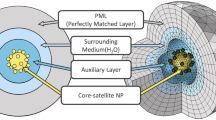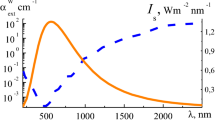Abstract
The plasmonic effect is introduced in solar thermal areas to enhance light harvest and absorption. The optical properties of plasmonic nanofluid are simulated by finite difference time domain (FDTD) method. Due to the excitation of localized surface plasmon resonance (LSPR) effect, an intensive absorption peak is observed at 0.5 μm. The absorption characteristics are sensitive to particle size and concentration. As the particle size increases, the absorption peak is broadened and shifted to longer wavelength. The absorption of SiO2/Ag plasmonic nanofluid is improved gradually as the volume concentration increases, especially in the UV region. The absorption edge is shifted from 0.6 to 1.0 μm as the volume concentration increases from 0.001 to 0.01. The thermal simulation of suspended SiO2/Ag nanoparticle shows a uniform temperature rise of 17.91 K under solar irradiation (AM 1.5), while under the same condition, the temperature rises in Ag nanoparticle and Al nanoparticle are 11.12 and 5.39 K, respectively. The core/shell plasmonic nanofluid exhibits a higher photothermal performance, which has a potential application in photothermal areas. A higher temperature rise can be obtained by improving the incident light intensity or optical absorption properties of nanoparticles.







Similar content being viewed by others
References
Otanicar TP (2011) Enhancing the heat transfer in energy systems from a volumetric approach. In: ASME/JSME 2011 8th Thermal Engineering Joint Conference. ASME, Hawaii
Lenert A, Wang EN (2012) Optimization of nanofluid volumetric receivers for solar thermal energy conversion. Sol Energy 86(1):253–265
Saidur R, Meng TC, Said Z, Hasanuzzaman M, Kamyar A (2012) Evaluation of the effect of nanofluid-based absorbers on direct solar collector. Int J Heat Mass Transf 55:5899–5907
Otanicar TP, Phelan PE, Prasher RS, Rosengarten G, Taylor RA (2010) Nanofluid-based direct absorption solar collector. J Renewable Sustainable Energy 2:033102
Moghadam AJ, Farzane-Gord M, Sajadi M, Hoseyn-Zadeh M (2014) Effects of CuO/water nanofluid on the efficiency of a flat-plate solar collector. Exp Thermal Fluid Sci 58:9–14
Taylor RA, Phelan PE, Otanicar TP, Adrian R, Prasher R (2011) Nanofluid optical property characterization: towards efficient direct absorption solar collectors. Nanoscale Res Lett 6:225/1–225/11
Lee S-H, Jang SP (2015) Efficiency of a volumetric receiver using aqueous suspensions of multi-walled carbon nanotubes for absorbing solar thermal energy. Int J Heat Mass Transf 80:58–71
He Q, Zeng S, Wang S (2015) Experimental investigation on the efficiency of flat-plate solar collectors with nanofluids. Appl Therm Eng 88:165–171
Maier SA (2006) Plasmonics: fundamentals and applications. Springer, New York
Yao J, Le A-P, Gray SK, Moore JS, Rogers JA, Nuzzo RG (2010) Functional nanostructured plasmonic materials. Adv Mater 22:1102–1110
Hu Y, Fleming RC, Drezek RA (2008) Optical properties of gold-silica-gold multilayer nanoshells. Opt Express 16(24):19579–19591
Filho EPB, Mendoza OSH, Beicker CLL, Menezes A, Wen D (2014) Experimental investigation of a silver nanoparticle-based direct absorption solar thermal system. Energy Convers Manag 84:261–267
Zhang H, Chen H-J, Du X, Wen D (2014) Photothermal conversion characteristics of gold nanoparticle dispersions. Sol Energy 100:141–147
Li Q, Zhang W, Zhao D, Qiu M (2014) Photothermal enhancement in core-shell structured plasmonic nanoparticles. Plasmonics 9:623–630
Wang H, Tam F, Grady NK, Halas NJ (2005) Cu nanoshells: effects of interband transitions on the nanoparticle plasmon resonance. J Phys Chem B 109(39):18218–18222
Diao JJ, Chen GD (2001) Electromagnetic cavity resonant absorption of the gold nanoshell. J Phys D Appl Phys 34:L79–L82
Averitt RD, Sarkar D, Halas NJ (1997) Plasmon resonance shifts of Au-coated Au2S nanoshells: insight into multicomponent nanoparticle growth. Phys Rev Lett 78(22):4217–4220
Duan H, Xuan Y (2014) Enhanced optical absorption of the plasmonic nanoshell suspension based on the solar photocatalytic hydrogen production system. Appl Energy 114:22–29
Oubre C, Nordlander P (2004) Optical properties of metallodielectric nanostructures calculated using the finite difference time domain method. J Phys Chem B 108(46):17740–17747
Yee KS (1966) Numerical solution of initial boundary value problems involving Maxwell’s equations in isotropic media. IEEE Trans Antennas Propag 14(3):302–307
Coronado EA, Schatz GC (2003) Surface plasmon broadening for arbitrary shape nanoparticles: a geometrical probability approach. J Chem Phys 119:3926–3934
Palik DE (1985) Handbook of optical constants of solids. Academic Press Inc., London
Qiu TQ, Tien CL (1993) Size effects on nonequilibrium laser heating of metal films. Trans ASME 115:842–847
Davis JA, Venkatesan R, Kaloyeros A, Beylansky M, Souri SJ, Banerjee K, Saraswat KC, Rahman A, Reif R, Meindl JD (2001) Interconnect limits on gigascale integration (GSI) in the 21st century. Proc IEEE 89:305–324
Chen X (2014) Photothermal effect in plasmonic nanostructures and its applications. KTH School of Information and Communication Technology
Brown MD, Suteewong T, Kumar RSS, D’Innocenzo V, Petrozza A, Lee MM, Wiesner U, Snaith HJ (2011) Plasmonic dye-sensitized solar cells using core-shell metal-insulator nanoparticles. Nano Lett 11:438–445
Xuan Y, Duan H, Li Q (2014) Enhancement of solar energy absorption using a plasmonic nanofluid based on TiO2/Ag composite nanoparticles. RSC Adv 4:16206–16213
Duan H, Xuan Y, Li Q (2015) Optical absorption properties and control method of nanostructures. Chin Sci Bull 60(24):2338–2343
Chu TC, Liu W-C, Tsai DP (2005) Enhanced resolution induced by random silver nanoparticles in near-field optical disks. Opt Commun 246:561–567
Hao E, Li S, Bailey RC, Zou S, Schatz GC, Hupp JT (2004) Optical properties of metal nanoshells. J Phys Chem B 108(4):1224–1229
Acknowledgements
This work was financially supported by the National Natural Science Foundation of China (Grant No. 51506044) and the Fundamental Research Funds for the Central Universities (2014B13014).
Author information
Authors and Affiliations
Corresponding author
Rights and permissions
About this article
Cite this article
Duan, H., Tang, L., Zheng, Y. et al. Optical and Thermal Enhancement of Plasmonic Nanofluid Based on Core/Shell Nanoparticles. Plasmonics 13, 1135–1141 (2018). https://doi.org/10.1007/s11468-017-0613-2
Received:
Accepted:
Published:
Issue Date:
DOI: https://doi.org/10.1007/s11468-017-0613-2




